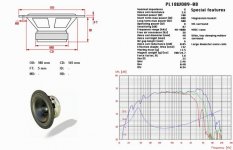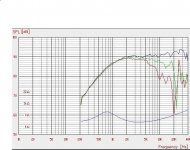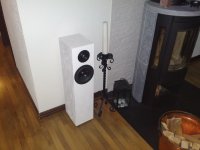I started this project a long time ago (10+ years) but I had no time and interest to really finish it off. It consist of a tweeter D25AG-35-06 and woofer PL18WO-08-09. Box is vented floor stand of 23 liters. My intention was to build a decent DIY speaker. However, I never finished the filter design properly and it has sounded quite bad for over 10 years now. I thought I might do something about it and my conclusions is that a 4th order Linkwitz-riley crossed at 1600 Hz will be a good start.
But, there is a problem. I can not find any data for the D25AG-36-06 tweeter on internet! Every datasheet is lacking important parameter data and there is no FRD or ZMA to be find either. I was thinking of getting a D27TG dome instead since it might fit the woofer better and there is a lot of data available. Does anyone have a clue where to find data for the D25AG tweeter?? I know it's very old, from 1992 or something, but it is popular for DIY project so there must be data somewhere.
But, there is a problem. I can not find any data for the D25AG-36-06 tweeter on internet! Every datasheet is lacking important parameter data and there is no FRD or ZMA to be find either. I was thinking of getting a D27TG dome instead since it might fit the woofer better and there is a lot of data available. Does anyone have a clue where to find data for the D25AG tweeter?? I know it's very old, from 1992 or something, but it is popular for DIY project so there must be data somewhere.
I built a similar project years ago with an 8" Vifa as a passive (AEM August 1985). When I gambled on making it active, I was amazed at how much better it sounded; cleaner, no sibilance on vocals, controlled and louder without the distortion I was used to.
Yes, thanks I already have that one. But what is VAS, Qms, Qes, Qts?? Don't I need that to make a 4th order L-R filter? I'm sorry but I'm a novice at filter design..
Hi, no you don't need the T/S parameters to design the filter. Very few tweeters have published T/S params!
The SPL trace and the impedance curve should be enough to get you going. You can use spltrace or another program which I found that works even better SPL Copy - Speaker Frequency Response Automatic Trace Tool to get frd and zma files.
Then you can use something like Jeff Bagby's PCD to simulate a crossover (after extracting phase with another of his spreadsheets the response modeller one).
Alternatively have a read of Allen's excellent sticky for designing a crossover without measurements (you should read it even if you are ultimately going to do simulations).
Tony.
The SPL trace and the impedance curve should be enough to get you going. You can use spltrace or another program which I found that works even better SPL Copy - Speaker Frequency Response Automatic Trace Tool to get frd and zma files.
Then you can use something like Jeff Bagby's PCD to simulate a crossover (after extracting phase with another of his spreadsheets the response modeller one).
Alternatively have a read of Allen's excellent sticky for designing a crossover without measurements (you should read it even if you are ultimately going to do simulations).
Tony.
Last edited:
I have a three set of PL18's, still going strong. The boxes are not near 23liters but they have a lot of bass.
Have a xo design with them for a Morel MDT 28-30 tweeter if needed.
Have a xo design with them for a Morel MDT 28-30 tweeter if needed.
Admit it, my friend, you are clueless what to do with this fairly random combination of drivers! 1600Hz L/R crossover? Ridiculously low for an average metal dome! It won't work. 🙄and my conclusions is that a 4th order Linkwitz-riley crossed at 1600 Hz will be a good start.
A 7 inch paper woofer with a peak around 4.5kHz is fairly typical, but I would need some serious modelling to do much with it. Possibly a woofer notch around 4.5 kHz. We're probably looking at a third order tweeter filter crossing over around 2.8kHz.
But I'm not wasting time on that. Here's a Troels Gravesen design for your woofer in a similar reflex box with the similar 104mm Vifa XT25 tweeter:
Vifa PL18WO-
Troels' stuff is always good. Buy new XT25 tweeters and adapt his design. I wouldn't lose too much sleep over the exact box dimensions. 🙂
Attachments
Hi, no you don't need the T/S parameters to design the filter. Very few tweeters have published T/S params!
The SPL trace and the impedance curve should be enough to get you going. You can use spltrace or another program which I found that works even better SPL Copy - Speaker Frequency Response Automatic Trace Tool to get frd and zma files.
Then you can use something like Jeff Bagby's PCD to simulate a crossover (after extracting phase with another of his spreadsheets the response modeller one).
Alternatively have a read of Allen's excellent sticky for designing a crossover without measurements (you should read it even if you are ultimately going to do simulations).
Tony.
Thanks a lot! Yes, I was going to use the PCD spreedsheet to make something useful. Now I know a little better. 😛
Yes, exactly that page for PL18WO was my starter for this idea. That is for the D27TG tweeter but just looking at the spec they seems pretty similar. He uses 1500 Hz for a 4th order L-R but the tweeter has fs=750 Hz. My tweeter has fs=850 Hz so I think 1600 Hz is the lowest to go.
They where good drivers at the time buying them so yes, the potential is there. I bought them on a sellout so they didn't cost much either. 😀
Here is what they look like now..
/Fredrik
Attachments
Admit it, my friend, you are clueless what to do with this fairly random combination of drivers! 1600Hz L/R crossover? Ridiculously low for an average metal dome! It won't work. 🙄
Hmm, are you sure? Check this out: VIFA PL18WO Near Field Monitors by AmpsLab
The PL18WO woofer is not very good over 2 kHz so a 4th order will cut the nasty ripples. Also what I can read the D25AG can go down to 1500 Hz but as a "thumb rule" I also read something about not going lower than fs*2 so 1600 Hz is probably the lowest. Both D25AG and D27TG is low performers and according to many they sound best from 2-4 kHz with completely straight curve.
After a bit reading about filter I came to the conclusion that 4th order Linkwitz-Riley is the most used in "high end" speakers mostly because it gives 0 dB raise over crossover and little to none phase shift. The impedance on D25AG can be tricky what I have found out so a Linkwitz-Riley is the best suited for that driver as I suppose.
But as I sad, I'm a novice on filters so I might be wrong on that one..
A 7 inch paper woofer with a peak around 4.5kHz is fairly typical, but I would need some serious modelling to do much with it. Possibly a woofer notch around 4.5 kHz. We're probably looking at a third order tweeter filter crossing over around 2.8kHz.
But I'm not wasting time on that. Here's a Troels Gravesen design for your woofer in a similar reflex box with the similar 104mm Vifa XT25 tweeter:
Vifa PL18WO-
Troels' stuff is always good. Buy new XT25 tweeters and adapt his design. I wouldn't lose too much sleep over the exact box dimensions. 🙂
I was thinking of getting a newer silk-tweeter but since I already have this setup I think it's better do something with that. It's not a bad tweeter and many think it actually sounds way better then silk-domes. Matter of taste I guess.
What I have now is a standard Butterworth 12 dB at 4 kHz crossover and my conclusion is that mid-range is not sounding good at all. It's doing good bass and higher up over 10 kHz is okay but voices and guitars sounds way too harsh and aggressive. My guess is that I have a nasty peak around 4-5 kHz with my filter so going below 2 kHz with 4th order was my idea. Thanks for the reply.
/Fredrik
Yes 4K 2nd order is not going to be good with the breakup on that woofer (if it is the graph that Steve posted)! A notch filter on the woofer somewhere between 3 and 4k probably would be a good idea (even if you go with a low 4th order crossover).
Looking at the graph for the tweeter I think you would really be pushing it crossing over below 2Khz.... a second order electrical around 2K is probably going to give you your 4th order acoustic slope. You may need to go 3rd order electrical on the woofer to get phase to match up.
If you are going to work with this tweeter and woofer I'd try for 2Khz and put a notch on the woofer. The notch may be tricky though as it is a fairly wide peak.
Tony.
Looking at the graph for the tweeter I think you would really be pushing it crossing over below 2Khz.... a second order electrical around 2K is probably going to give you your 4th order acoustic slope. You may need to go 3rd order electrical on the woofer to get phase to match up.
If you are going to work with this tweeter and woofer I'd try for 2Khz and put a notch on the woofer. The notch may be tricky though as it is a fairly wide peak.
Tony.
What I have now is a standard Butterworth 12 dB at 4 kHz crossover and my conclusion is that mid-range is not sounding good at all.
I've worked extensively on the PL18 and the D25AG. If you don't cross the PL18 low, you'll lose the mids. That's the reason why I went so low with the PL27 tweeter. I don't normally use a dome tweeter below 2kHz but this is an exception.
To get the vocals to stand out more, I attenuated the 500Hz region slightly. Otherwise, the vocals sound a bit nasal.
It's doing good bass and higher up over 10 kHz is okay but voices and guitars sounds way too harsh and aggressive.
That harshness/aggressiveness is because the tweeter is resonanting. The only way to overcome that is to use a LCR.
I've loaded the PL18 with a 25L vented box before, so I know it'll work with your 23L tower. All it takes is a proper crossover and your speakers will sound great.
I used to use D27s and the D25 when it came out. They are more similar than not. FWIW I tended to cross it at around 1k6Hz. I won't say that's perfect and I must have had a particular reason. I'm simply saying it will function there if you want it to.
Interesting that you guys have crossed this tweeter so low! The fact it is already well and truly rolling off at this frequency would make me think that you would not be able to use more than 2nd order electrical on it (unless you are doing something like 6th order acoustic)
I don't imagine it can handle much power with a cross that low. I'm very wary now of low tweeter crossing after Lynn Olson's post on the evils of doing so, and the subsequent redeisgn of my crossover substantially improving the sound. Of course that is but one instance 🙂
Tony.
I don't imagine it can handle much power with a cross that low. I'm very wary now of low tweeter crossing after Lynn Olson's post on the evils of doing so, and the subsequent redeisgn of my crossover substantially improving the sound. Of course that is but one instance 🙂
Tony.
Second order could extend the response if you allow it to be less damped, otherwise I'd basically agree with what you're saying. For one thing I used to have to voice them once they'd been warmed up.
As to why I'd be guessing but I'd say it was probably the directivity dip and the sensitivity in that region to crossing with issues like that...which drove me to run them too hot. I probably didn't need to go much lower than about 2k for this in hindsight. I could have used smaller mids.
As to why I'd be guessing but I'd say it was probably the directivity dip and the sensitivity in that region to crossing with issues like that...which drove me to run them too hot. I probably didn't need to go much lower than about 2k for this in hindsight. I could have used smaller mids.
Ok, thanks for the information! So if I'm going with 2nd order at 2 kHz with LCR for the tweeter and 3rd order at 2 kHz with LCR for the woofer it will be a properly working filter for this speaker?
That was just an educated guess and may be completely off! 🙂 best thing to do is trace the curves put them in the simulator and have a look. I'm just going off my build experience and a number of sims that I've done for other drivers. What has worked best for me has usually been 2nd order electrical on the woofer and third order on the tweeter (to get good phase tracking) and a 4th order target accoustic slope.
With your drivers and the low crossover point I suspect that 2nd on the tweeter and 3rd on the woofer will be more likely to give a 4th order acoustic slope 🙂
Tony.
With your drivers and the low crossover point I suspect that 2nd on the tweeter and 3rd on the woofer will be more likely to give a 4th order acoustic slope 🙂
Tony.
With your drivers and the low crossover point I suspect that 2nd on the tweeter and 3rd on the woofer will be more likely to give a 4th order acoustic slope 🙂
Tony.
Well it sounds like a good idea to me so I will try it in PCD and see what I can do. Thanks!
/Fredrik
- Status
- Not open for further replies.
- Home
- Loudspeakers
- Multi-Way
- Old Vifa 2-way speaker project


